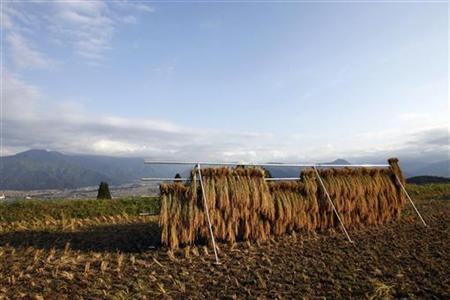El Nino emerges, raising fears over food prices
Date: 13-Aug-12
Country: JAPAN
Author: Risa Maeda

Bundled stalks of rice plants are hung at a rice paddy in
Minami-Uonuma, north of Tokyo, October 18, 2007.
Photo: Toru Hanai
An El Nino weather pattern is underway and will last until winter, Japan said on Friday, foreshadowing disruptive conditions that could harm crops from Australia to India at a time of rising fears about global food supplies.
Corn prices have surged more than 60 percent in the past two months as the United States reels from the worst drought in more than 50 years, while global soy supplies are also tight after drought in South America.
Data suggested the El Nino phenomenon had emerged, the Japan Meteorological Agency said, referring to conditions in the equatorial Pacific.
"The chances are high that the El Nino phenomenon will be maintained until the winter," the agency said in a statement.
Adding to worries, the U.N.'s Food and Agriculture Organization said on Thursday the world was closer to a repeat of a 2008 food crisis because of a spike in food costs.
The big unknown is how intense and how long the developing El Nino phenomenon will be. An intense El Nino can cause widespread drought in Australia, parts of Africa, Southeast Asia and India, but also bring rains to other parts of the globe.
While it can boost corn and soy crops in South America, wheat harvests can be devastated in Australia. Coffee, cocoa, rice and sugar output in Southeast Asia can also be hit.
Officials said El Nino could kick in at the end of the Indian monsoon in September, hurting winter wheat, rapeseed and chickpea crops.
Drier weather would be good for China's autumn grain growing period, mostly corn and soybean, which accounts for more than 70 percent of the country's total grain output, a senior Chinese meteorological official said.
El Nino is a warming of sea-surface temperatures in the equatorial Pacific that occurs every four to 12 years. It is the opposite of the very closely related La Nina pattern, which often triggers floods in Australia and parts of Asia. Intense back-to-back La Nina episodes occurred during 2010-12.
The U.S. Climate Prediction Center, part of the National Oceanic Atmospheric Administration (NOAA), also warned on Thursday that an El Nino was almost certain to occur over the next two months.
The last severe El Nino in 1998 caused drought in Australia and Southeast Asia, withering crops and triggering forest fires.
El Nino can also bring warmer, wetter winters in Japan and parts of North America, but any rains might be too late for the parched U.S. corn crop.
Concepcion Calpe, senior economist at the FAO, said she expected a mild El Nino to develop but it could bring "some bad weather which could jeopardize crops in the coming months".
"We expect more rain in the United States in the coming months, but it will be too late for the maize crop. It is impossible now (for it) to recover," Calpe said.
"But there is still time for the rains to boost soy yields. We are looking forward to having rain in August and September, that would be great for the soya crop."
WORRIES IN INDIA; CHINA UNFAZED
Indonesia's weather bureau said on Friday any El Nino would have limited impact on the country.
"A weak El Nino will reduce rainfall in eastern and central Indonesia, but not significantly," weather bureau head Sri Woro B. Harijono told reporters.
But in India, one of the world's largest food producers and consumers, with a population of 1.2 billion, El Nino will likely mean a drop in rainfall from September after an erratic monsoon.
Lower than average rains have threatened cereal and lentils production, although rainfall has picked up in the past week.
El Nino typically causes drier weather over much of the country during the northern hemisphere summer, forecasters say.
"El Nino is likely to reduce rainfall during the last month of the monsoon season," said D.S. Pai, lead forecaster of the Indian weather office, referring to September. That could cut winter crop production.
Three years ago, an El Nino slowed monsoon rains, sparking a rally in sugar prices to 30-year highs as India, the world's second biggest producer, harvested a poor cane crop.
In China, little impact was expected.
"The influence of El Nino on Chinese crops will help postpone frost in northern China at the later part of the autumn months, which will be beneficial for crops," said Tu Xuan, an analyst at Shanghai JC Intelligence Co. Ltd.
Elsewhere, the phenomenon raises the chances of favorable planting conditions in South America for corn and soy.
"There may be areas that are adversely affected, but no two El Nino are the same. It is certainly a risk but it doesn't mean that we are going to have a disaster," said Luke Mathews, a commodities strategist at the Commonwealth Bank of Australia.
He said the bank was expecting good crops in South America over the next six months and there was enough soil moisture in eastern Australian cropping zones to buffer against a drought.
El Nino also generally leads to a decrease in storms in the Atlantic and the Gulf of Mexico, potentially good news for the oil industry whose installations are vulnerable to hurricanes.
The U.S. government forecaster said on Thursday El Nino would bring near-normal to above-normal storm activity. The hurricane season runs to November 30.
El Nino means "little boy" in Spanish and was first used by anchovy fishermen in Ecuador and Peru in the 19th century to refer to the arrival of unusually warm ocean waters around Christmas.
(Additional reporting by Naveen Thukral in Singapore, Ratnajyoti Dutta in New Delhi, Tracy Zheng and Sabrina Mao in Beijing,; Yayat Supriatna in Jakarta and Catherine Hornby in Rome; Editing by David Fogarty, Robert Birsel, Clarence Fernandez and Giles Elgood)
![]()
© Thomson Reuters 2012 All rights reserved